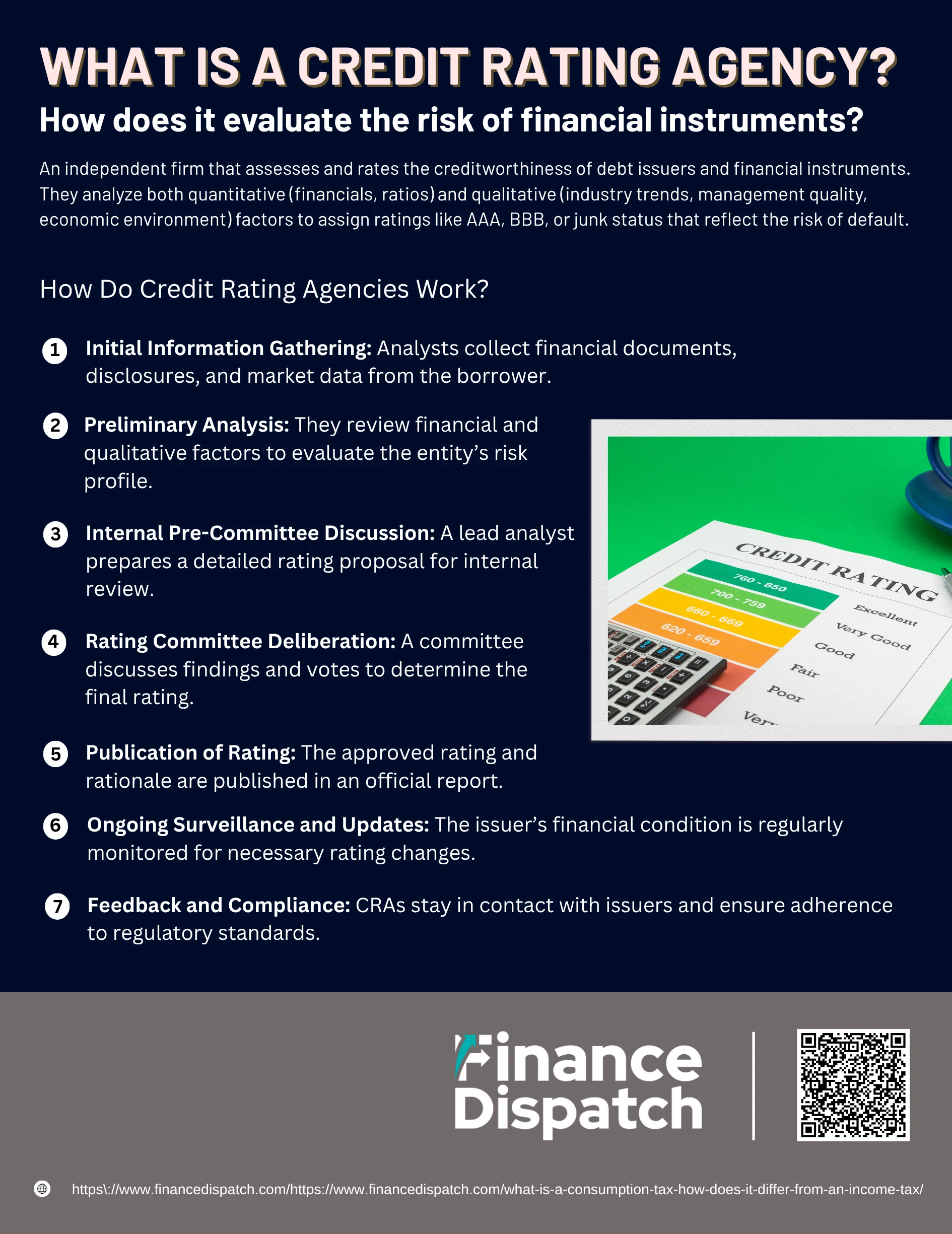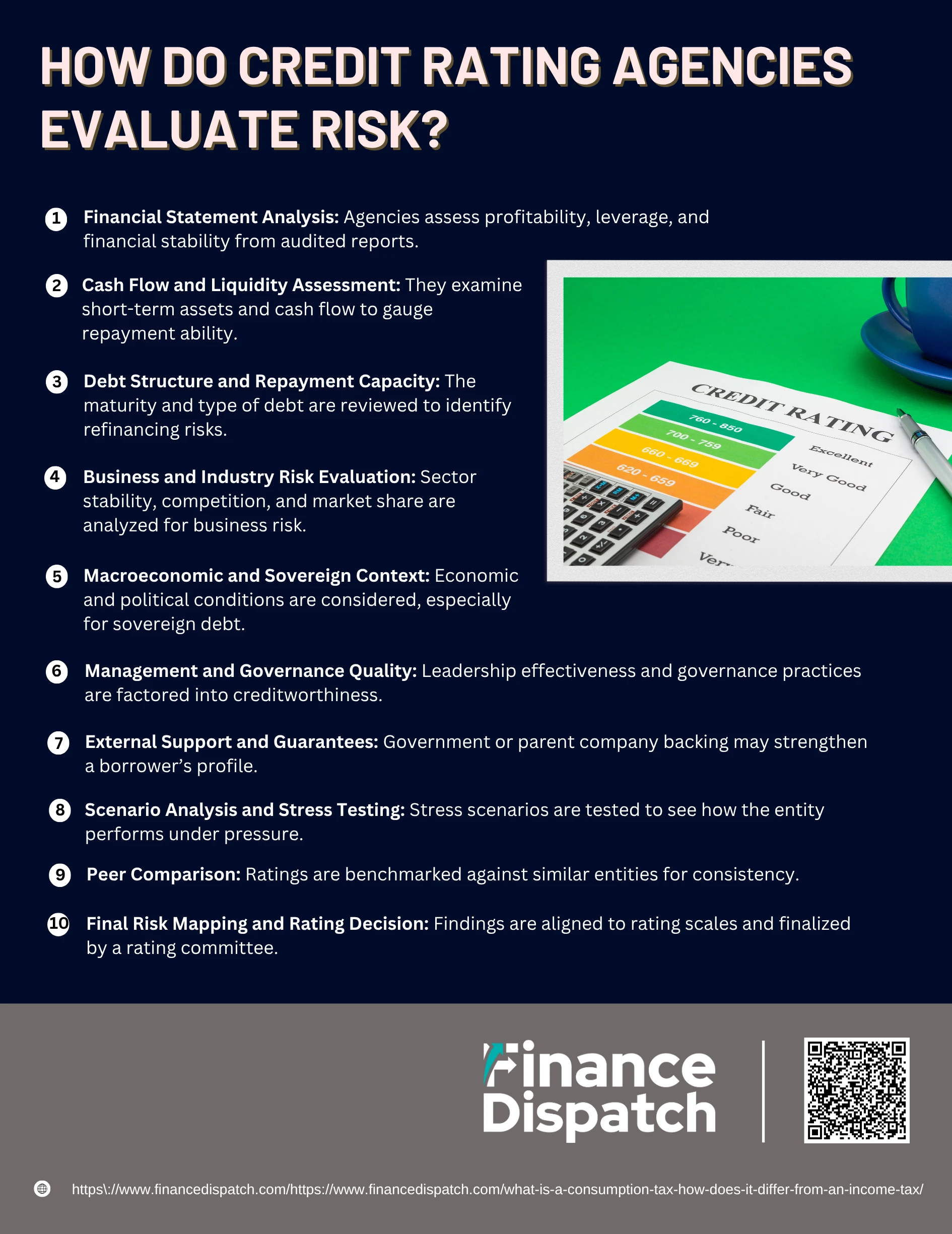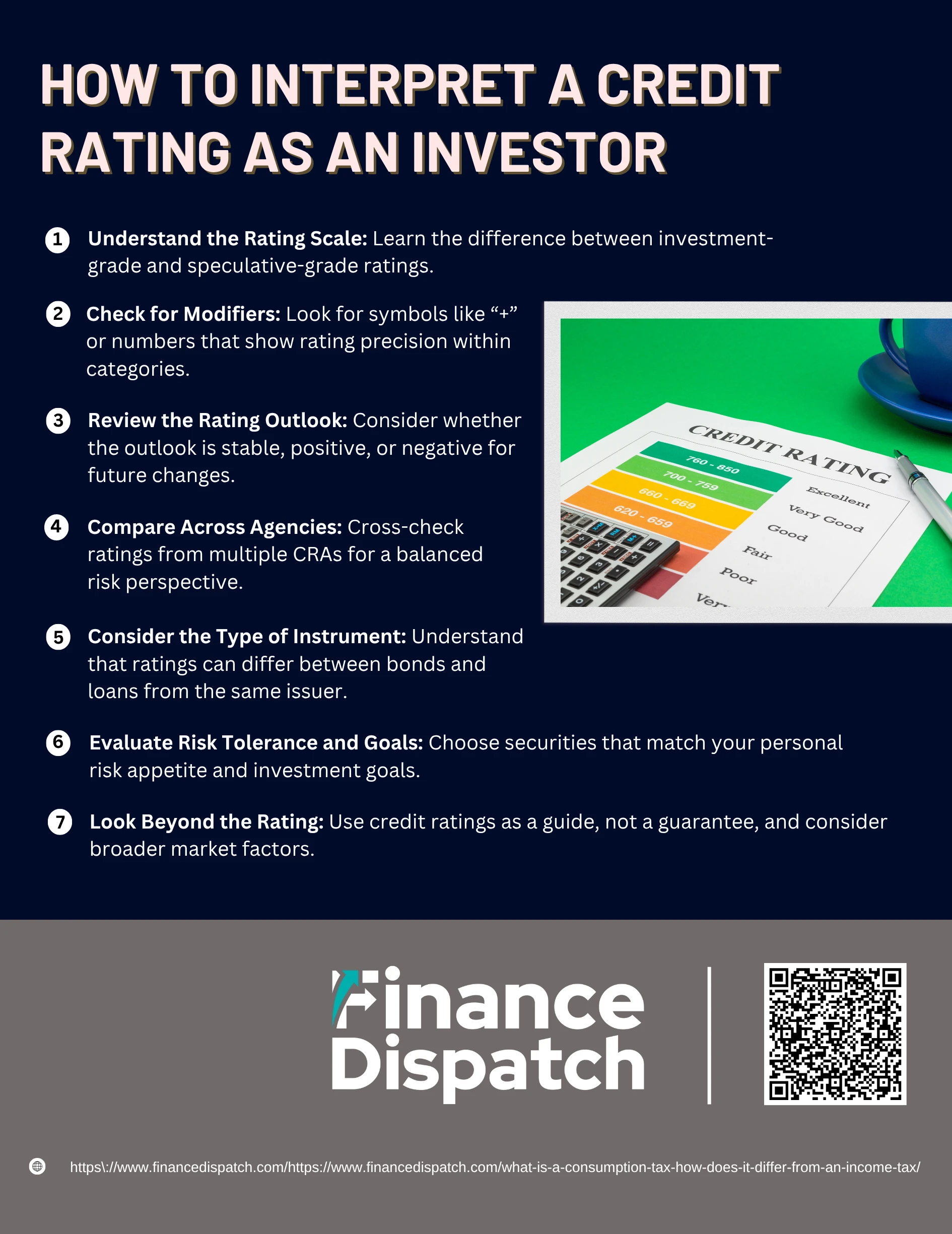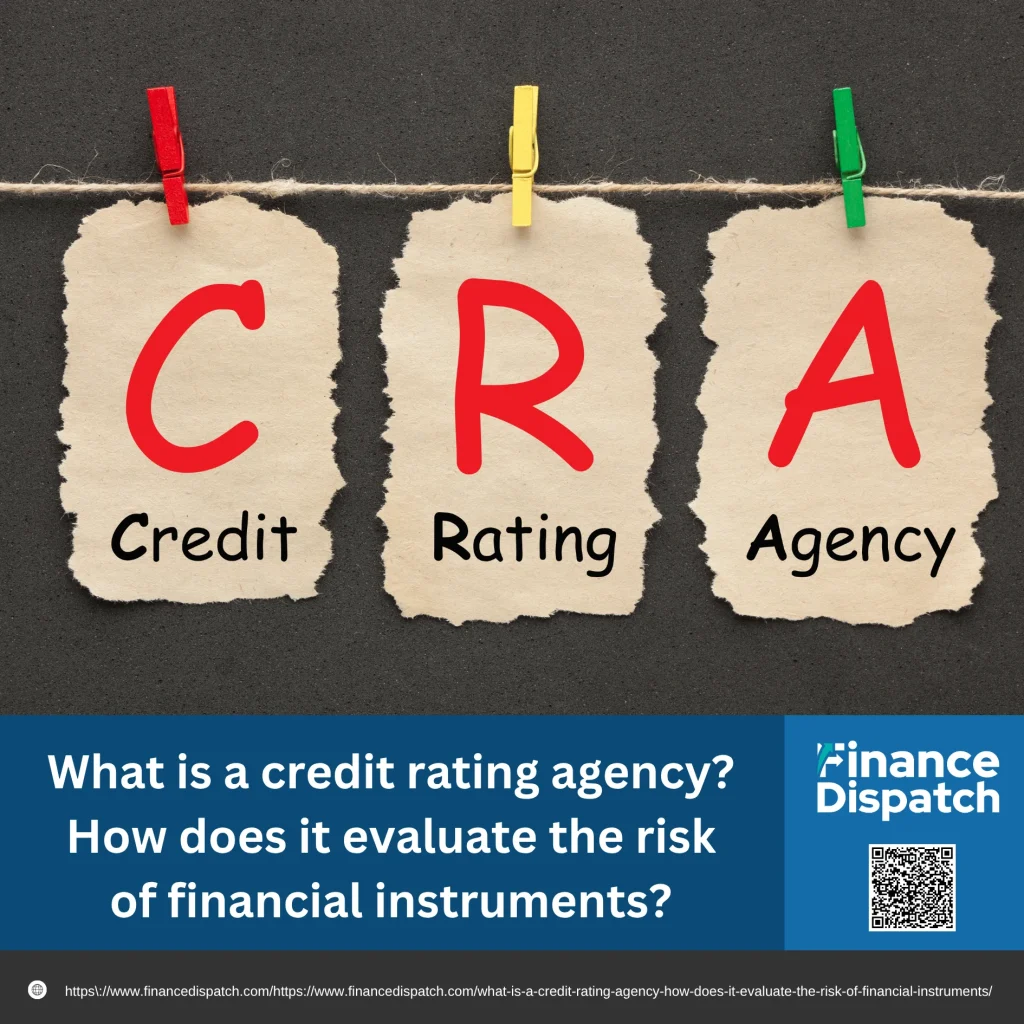In today’s complex financial world, making informed investment decisions requires clear and credible insights into the creditworthiness of borrowers—be they governments, corporations, or financial institutions. This is where credit rating agencies (CRAs) come in. These specialized organizations assess the ability of entities to meet their financial obligations and assign ratings that reflect the level of risk involved. These ratings, typically expressed as letter grades like AAA or BBB-, serve as vital signals for investors, lenders, and policymakers. But what exactly is a credit rating agency, and how does it determine the risk level of financial instruments such as bonds, loans, and securities? This article unpacks the role of CRAs, their evaluation methodologies, and why their influence is both essential and controversial in global finance.
What is a Credit Rating Agency (CRA)
A Credit Rating Agency (CRA) is an independent organization that evaluates the financial strength and creditworthiness of entities such as corporations, governments, and financial institutions. Its primary role is to assess the likelihood that a borrower will be able to meet its debt obligations in full and on time. Based on this analysis, the agency assigns a credit rating—usually in the form of standardized letter grades—that reflects the level of risk associated with lending to or investing in that entity. These ratings help investors quickly understand the relative safety or risk of financial instruments like bonds, loans, and securities. By offering an impartial opinion based on both qualitative and quantitative data, CRAs act as vital intermediaries in the financial markets, supporting transparency, investor confidence, and efficient capital allocation.
Key Credit Rating Agencies in the World
The global credit rating industry is dominated by three major players commonly known as the “Big Three”: Moody’s Investors Service, Standard & Poor’s (S&P), and Fitch Ratings. These agencies collectively control around 95% of the market and are considered authoritative sources of credit assessments worldwide. Each of them has developed its own methodology and rating scale, but all serve the same fundamental purpose—to evaluate the credit risk of issuers and financial instruments. Their ratings influence everything from borrowing costs to investment strategies, making them crucial pillars of the financial system.
Major Credit Rating Agencies and Their Characteristics
| Agency | Founded | Headquarters | Rating Scale Highlights | Notable Features |
| Moody’s | 1909 | New York, USA | Aaa to C (with numeric modifiers 1–3) | Known for deep research and global debt coverage |
| Standard & Poor’s (S&P) | 1941 (roots in 1860) | New York, USA | AAA to D (uses +/– for refinements) | Publishes S&P 500 Index; oldest among the Big Three |
| Fitch Ratings | 1913 | New York, USA & London, UK | AAA to D (uses +/– like S&P) | Smaller but widely used; rigorous default risk methodology |
 How Do Credit Rating Agencies Work?
How Do Credit Rating Agencies Work?
Credit rating agencies (CRAs) function as financial gatekeepers, offering independent assessments of how likely a borrower is to repay its debt on time and in full. These assessments help investors make smarter decisions and support overall market stability. But assigning a credit rating is far from a simple task—it involves a meticulous process that blends data analysis, industry insight, committee judgment, and regulatory compliance. Each rating is backed by deep research and expert review, and the entire process is designed to be objective, transparent, and robust.
Steps in the Credit Rating Process
1. Initial Information Gathering
The process begins when a borrower—typically a corporation, government, or financial institution—seeks a credit rating. The CRA’s analysts collect detailed information, including audited financial statements, management commentary, debt repayment history, operational data, and any relevant disclosures. Analysts may also consider publicly available market data, industry outlooks, and peer comparisons.
2. Preliminary Analysis
Analysts examine the financial condition and risk profile of the entity. This includes evaluating revenue trends, debt levels, interest coverage, cash flow projections, and exposure to economic or geopolitical risks. Qualitative factors such as management quality and corporate governance are also considered. If this early review deems the data insufficient or unclear, the rating process may be paused or rejected.
3. Internal Pre-Committee Discussion
Once the initial analysis is complete, the lead analyst compiles a comprehensive review package. This includes the proposed rating and justification, sensitivity analyses, and identified risk factors. The package is reviewed internally and prepared for formal presentation to the rating committee.
4. Rating Committee Deliberation
A formal committee—typically composed of senior analysts and sector specialists—convenes to discuss the review package. This group rigorously debates the analyst’s findings, challenges assumptions, and applies the agency’s rating criteria. The committee then votes on the final rating, with majority opinion determining the outcome.
5. Publication of Rating
After approval, the rating is officially published along with an explanatory report. This document outlines the rationale behind the rating, the key financial drivers, and potential risks. It helps investors and other stakeholders understand the reasoning and context behind the score.
6. Ongoing Surveillance and Updates
Ratings are monitored continuously, especially for changes in the issuer’s financial standing, sector dynamics, or global economic trends. If new developments arise—such as a merger, major default, or economic downturn—the rating may be upgraded, downgraded, or placed on a watchlist.
7. Feedback and Compliance
The CRA maintains communication with the rated entity, updating it on surveillance timelines and collecting additional data as needed. Meanwhile, agencies are required to adhere to internal compliance frameworks and regulatory standards, such as those set by the SEC (U.S.) or ESMA (EU), to ensure the integrity of the process and minimize conflicts of interest.
 How Do Credit Rating Agencies Evaluate Risk?
How Do Credit Rating Agencies Evaluate Risk?
Credit rating agencies evaluate risk by analyzing a wide range of financial, economic, and operational data to determine the likelihood that a borrower will default on its debt obligations. This assessment helps investors gauge the relative safety of financial instruments such as bonds, loans, and other securities. The agencies use a combination of quantitative metrics—like cash flow ratios and debt levels—and qualitative judgments—such as management quality and industry conditions—to form a comprehensive view of credit risk. Below is a step-by-step breakdown of how credit rating agencies conduct this evaluation.
Steps in Risk Evaluation by Credit Rating Agencies
1. Financial Statement Analysis
Agencies start by reviewing audited financial statements, focusing on key indicators such as revenue stability, profit margins, operating income, interest coverage ratio, and debt-to-equity ratio. These metrics help assess the issuer’s financial health and ability to service its debts.
2. Cash Flow and Liquidity Assessment
Analysts examine cash flow projections and liquidity ratios to determine whether the entity has sufficient short-term assets to meet its obligations. Consistent positive cash flow is a strong indicator of low credit risk.
3. Debt Structure and Repayment Capacity
The agency assesses the composition and maturity of existing debt. This includes analyzing how much debt is short-term versus long-term and identifying potential refinancing risks or balloon payments.
4. Business and Industry Risk Evaluation
The agency evaluates the competitive position of the company, market share, customer base, revenue diversification, and the overall stability of the industry it operates in. Sectors with cyclical demand or regulatory uncertainty may carry higher inherent risk.
5. Macroeconomic and Sovereign Context
Economic trends such as inflation, interest rates, exchange rates, and GDP growth are considered, especially when evaluating government or corporate debt in emerging markets. Political stability and policy transparency also weigh heavily in sovereign ratings.
6. Management and Governance Quality
Analysts consider the experience, track record, and credibility of the company’s leadership. Effective risk management, internal controls, and transparency are positive factors in creditworthiness.
7. External Support and Guarantees
In some cases, especially with public-sector or multinational companies, external backing such as government guarantees or parent company support is factored into the risk evaluation.
8. Scenario Analysis and Stress Testing
Agencies simulate adverse scenarios—like recessions, currency shocks, or demand slumps—to understand how the issuer might perform under pressure. The resilience of financial ratios under stress conditions helps determine the rating level.
9. Peer Comparison
The issuer’s performance is compared with similar companies or entities in the same sector or country. This benchmarking helps normalize ratings across different industries and regions.
10. Final Risk Mapping and Rating Decision
All findings are consolidated and matched against the agency’s internal rating scale. A final recommendation is made and submitted to a rating committee, where the credit rating is voted on and assigned.
Types of Instruments Rated
Credit rating agencies evaluate a wide range of financial instruments issued by corporations, governments, and financial institutions. Each instrument represents a different form of borrowing or credit exposure, and the assigned rating helps investors understand the level of risk associated with it. By providing standardized assessments, credit ratings allow market participants to compare diverse investment opportunities and manage their portfolios more effectively. Below are the primary types of instruments that are typically rated by credit rating agencies.
Commonly Rated Financial Instruments
1. Corporate Bonds
Debt securities issued by private or public corporations to raise capital for operations, expansion, or refinancing existing debt.
2. Government Bonds (Sovereign Debt)
Debt issued by national governments, typically considered low-risk for developed economies, but varying by country stability.
3. Municipal Bonds
Bonds issued by cities, states, or local government entities to fund public projects such as infrastructure, schools, or hospitals.
4. Structured Finance Products
Complex securities like mortgage-backed securities (MBS), asset-backed securities (ABS), and collateralized debt obligations (CDOs).
5. Bank Loans and Commercial Paper
Short-term, unsecured debt issued by corporations to meet working capital needs, often rated for liquidity and default risk.
6. Financial Institution Obligations
Ratings assigned to banks, insurance companies, and investment firms to assess their ability to meet liabilities and operational risks.
7. Sovereign and Sub-Sovereign Entities
Ratings not only for national governments but also for regions, provinces, and public sector undertakings within countries.
8. Project Finance and Infrastructure Debt
Long-term financing ratings for large-scale infrastructure projects like power plants, highways, or airports.
9. Mutual Funds and Investment Schemes
Some agencies also provide ratings for mutual funds or collective investment schemes based on their risk profile and portfolio quality.
10. Insurance and Reinsurance Products
Creditworthiness of insurance-related debt obligations, including claims-paying ability and reinsurance treaties.
Criticisms and Controversies around CRAs
Despite their essential role in financial markets, credit rating agencies (CRAs) have faced significant scrutiny and criticism over the years. Their influence on investment decisions and market stability has raised concerns about objectivity, transparency, and accountability. Major financial crises—most notably the 2008 global collapse—highlighted how flawed ratings can mislead investors and contribute to systemic risk. As a result, critics have questioned not only the reliability of ratings but also the business models and ethical practices behind them.
Key Criticisms and Controversies
1. Conflict of Interest (Issuer-Pays Model)
CRAs are typically paid by the entities they rate, raising questions about whether ratings are influenced by business interests rather than objective analysis.
2. Overly Optimistic Ratings before Crises
During the 2008 financial crisis, agencies gave high ratings (AAA) to mortgage-backed securities that later defaulted, contributing to widespread investor losses.
3. Lack of Accountability
Agencies present ratings as opinions rather than guarantees, limiting their legal liability even when their ratings prove highly inaccurate.
4. Delayed Downgrades
CRAs have been criticized for being slow to react to deteriorating financial conditions, issuing downgrades only after market damage is already done.
5. Opaque Methodologies
Many agencies do not fully disclose the models and assumptions used in their evaluations, reducing transparency for investors.
6. Market Oligopoly
The dominance of the “Big Three” (Moody’s, S&P, and Fitch) limits competition and alternative perspectives in the credit rating space.
7. Regulatory Overreliance
Financial regulations often embed reliance on credit ratings, which can lead to complacency among investors and regulatory bodies.
8. Rating Shopping
Issuers may approach multiple agencies and choose to publish only the most favorable rating, distorting the actual risk perception.
The Impact of Credit Ratings on Financial Markets
Credit ratings play a pivotal role in shaping the behavior of financial markets by influencing investor decisions, determining borrowing costs, and guiding regulatory compliance. A high credit rating signals low risk, enabling issuers to access capital at lower interest rates and attracting a broader pool of conservative investors. Conversely, a downgrade can trigger a sell-off, raise financing costs, and even restrict access to funding altogether. Institutional investors, such as pension funds and insurance companies, often have mandates that limit investments to securities with specific rating thresholds, making these ratings integral to portfolio construction. Moreover, credit ratings serve as benchmarks for risk assessment, pricing models, and asset allocation, making them deeply embedded in the financial ecosystem. Their influence is so widespread that even a single rating change can ripple across global markets, affecting currencies, equities, and interest rates.
 How to Interpret a Credit Rating as an Investor
How to Interpret a Credit Rating as an Investor
For investors, credit ratings serve as a quick reference to assess the risk level of various financial instruments such as bonds, loans, or structured products. Issued by credit rating agencies, these letter-grade scores provide a standardized measure of the issuer’s ability to meet its debt obligations. However, understanding what these ratings mean—and how to act on them—requires more than just recognizing that “AAA” is better than “BB.” By knowing how to interpret credit ratings in the right context, investors can make smarter, risk-adjusted decisions and better manage their portfolios.
Steps to Interpret a Credit Rating
1. Understand the Rating Scale
Familiarize yourself with the agency’s grading system. For example, Moody’s uses ratings from Aaa to C, while S&P and Fitch use AAA to D. Ratings are typically divided into two broad categories: investment grade (lower risk) and speculative grade (higher risk).
2. Check for Modifiers
Look for signs like “+,” “–,” or numerical modifiers (1, 2, 3) that indicate positioning within a category. For instance, “AA+” is stronger than “AA,” while “Ba1” is weaker than “Baa3.”
3. Review the Rating Outlook
Many ratings are accompanied by an “outlook”—positive, stable, or negative—that indicates the potential direction of future changes. A stable outlook suggests no change is likely soon, while a negative one signals increased risk.
4. Compare Across Agencies
Don’t rely on just one agency. Cross-check ratings from multiple sources (Moody’s, S&P, Fitch) for a more balanced view. Sometimes ratings may vary slightly due to different methodologies.
5. Consider the Type of Instrument
Ratings apply to specific instruments, not just issuers. A company might have an A-rated bond and a BB-rated subordinated loan, reflecting differences in repayment priority and risk.
6. Evaluate Risk Tolerance and Goals
Match the rating with your own risk appetite. If you’re a conservative investor, stick to investment-grade securities. If you can tolerate more risk for higher returns, you might explore speculative-grade or high-yield options.
7. Look Beyond the Rating
Treat credit ratings as a helpful guide—not the final word. Always consider broader factors such as economic conditions, market trends, and the issuer’s recent developments before making investment decisions.
Conclusion
Credit rating agencies are indispensable players in the global financial system, offering structured, independent evaluations of credit risk that help investors, lenders, and policymakers make informed decisions. By analyzing both quantitative and qualitative factors, these agencies assign ratings that act as benchmarks for investment safety and risk exposure. While their influence brings transparency and efficiency to markets, it also comes with significant responsibilities and challenges, including the need for greater accountability, regulatory oversight, and methodological clarity. For investors, understanding how these ratings are determined—and how to interpret them wisely—can lead to smarter, more strategic financial choices in an increasingly complex investment landscape.



